Composite absorbent particles
a technology of absorbent particles and absorbent particles, which is applied in the field of composite absorbent particles, can solve the problems of severe malodor production, poor odor control qualities of clay, and inability to effectively control malodors, and achieves low density, low tracking, and strong clumping
- Summary
- Abstract
- Description
- Claims
- Application Information
AI Technical Summary
Benefits of technology
Problems solved by technology
Method used
Image
Examples
example 1
Referring again to FIG. 1, a method for making particles 102 is generally performed using a pan agglomeration process in which clay particles of ≦200 mesh (≦74 microns), preferably ≦325 mesh (≦43 microns) particle size premixed with particles of active, are agglomerated in the presence of an aqueous solution to form particles in the size range of about 12×40 mesh (about 1650-250 microns). Alternatively, the particles are first formed with clay alone, then reintroduced into the pan or tumbler, and the active is added to the pan or tumbler, and a batch run is performed in the presence of water or a binder to adhere the active to the surface of the particles. Alternatively, the active can be sprayed onto the particles.
example 2
A method for making particles 104 is generally performed using the process described with relation to FIG. 2, except no core material is added.
example 3
A method for making particles 106 is generally performed using the process described with relation to FIG. 2, except that introduction of the absorbent granules and the active into the agglomerator are alternated to form layers of each.
PUM
| Property | Measurement | Unit |
|---|---|---|
| mean particle diameter | aaaaa | aaaaa |
| mean particle diameter | aaaaa | aaaaa |
| mean particle diameter | aaaaa | aaaaa |
Abstract
Description
Claims
Application Information
 Login to View More
Login to View More - R&D
- Intellectual Property
- Life Sciences
- Materials
- Tech Scout
- Unparalleled Data Quality
- Higher Quality Content
- 60% Fewer Hallucinations
Browse by: Latest US Patents, China's latest patents, Technical Efficacy Thesaurus, Application Domain, Technology Topic, Popular Technical Reports.
© 2025 PatSnap. All rights reserved.Legal|Privacy policy|Modern Slavery Act Transparency Statement|Sitemap|About US| Contact US: help@patsnap.com



